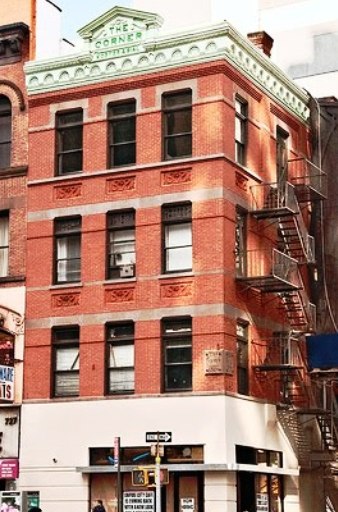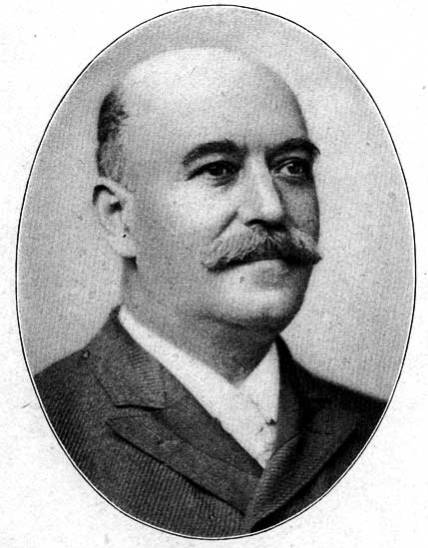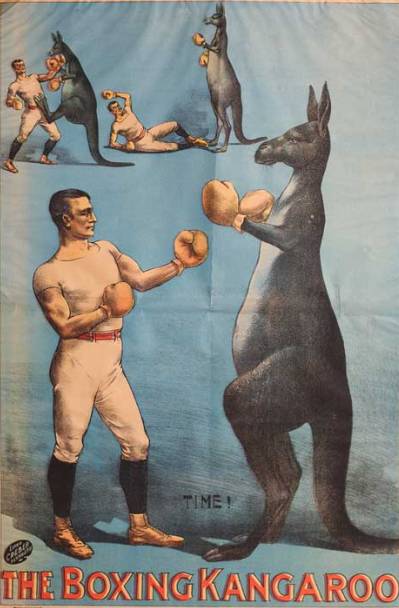
In the spring of 1893, 27-year-old Frank C. Bostock and his wife, Susannah Ethel Bailey, sold their shares of the Bostock, Wombell, and Bailey Circus (yes, that Bailey) and sailed from Liverpool to New York aboard the Bovic, a White Star Line steamship that specialized in the shipment of livestock. The couple didn’t travel alone; their traveling companions included three lions, a kangaroo, and several other large animals from the family’s traveling menagerie. Frank, their boxing kangaroo, would soon become a headliner at Koster and Bial’s Music Hall.
Upon arrival in New York, Frank set up his first exhibition stand near 5th Avenue and Flatbush Avenue in Brooklyn. A showman described the set-up this way: “The Bostock family lived in one wagon and the other two wagons housed four monkeys, five parrots, three lions, a sheep, and a boxing kangaroo.”
The kangaroo pugilist, whom Frank Bostock called Big Frank, had earned his fame in London at the Royal Aquarium. News of the British boxing kangaroo had generated much curiosity in the United States, so Bostock decided to introduce the act to New York.
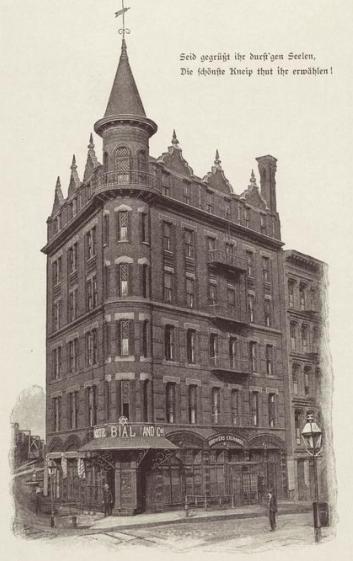
Big Frank made his American debut on June 1, 1893, at the Madison Square Garden Amphitheater. As The New York Times described the event, the kangaroo wore a pair of regulation boxing gloves on his forepaws and was over six feet tall when standing on his hind legs. He was escorted into the ring by his opponent, “a burly colored man.” (Yes, this was over 100 years ago.)
As soon as Frank Bostock called “Time!” the kangaroo hopped nimbly on his hind legs to the center of the ring with his paws in correct boxing position. He followed his opponent all about the ring, and used a downward chopping movement with his gloved paws. Every time he took a blow from his opponent, he used his tail to keep his balance.
The event ended with three rounds of sparring between Frank the kangaroo and Frank the circus man. Homosapien Frank won the match by throwing himself on marsupial Frank and toppling him to the ground.
Koster & Bial’s Music Hall
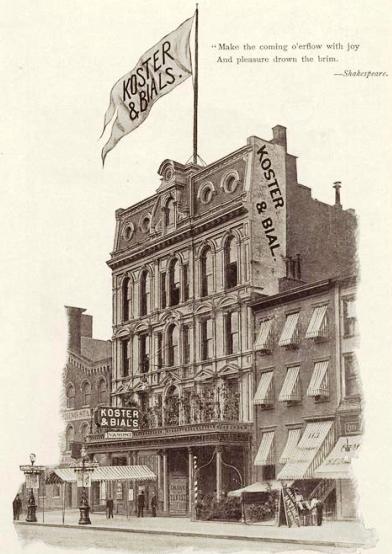
One month after making his rounds at Madison Square Garden, Frank the boxing kangaroo was a headliner at Koster & Bial’s Music Hall, a vaudeville theater and beer garden at the northwest corner of 23rd Street and 6th Avenue. Big Frank was apparently a big hit there, as they kept him on the program until the close of the season at the end of August.
Koster & Bial’s has an interesting history, to say the least.
John Koster and Albert Bial were both born in Germany in the 1840s and immigrated to America in the early 1860s. The two men reportedly met in 1869 when Koster hired Bial to work at his restaurant at 200 Worth Street, on the corner of Park Row.
They soon became partners in several restaurants as well as the beer-bottling business.
On May 5, 1879, Koster and Bial purchased a concert hall on 23rd Street near the corner of 6th Avenue. Built in 1870, the theater was originally called Bryant’s Opera House, the home of the popular blackface minstrel troupe, Bryant’s Minstrels.
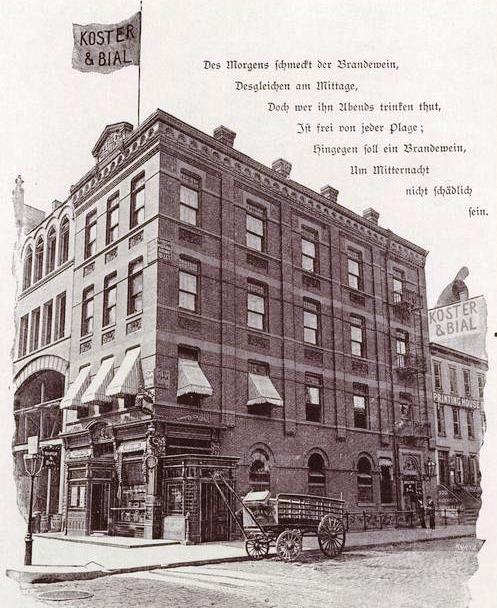
Following the death of Dan Bryant in 1875, the theater was then home to one concert hall after the other, including Darling’s Opera House, 23rd Street, Theatre Francaise, and the St. James.
In 1881 the partners expanded the business with a 1200-seat vaudeville theater at 115-117 West 23rd Street adjoining the older building. The property was owned by Alfred B. Darling, who also owned Proctor’s Theatre and who was a senior proprietor of the Fifth-Avenue Hotel.
To circumvent a law against serving alcohol in theaters, Koster and Bial replaced the stage curtain with a folding screen. That way, they could say they were a restaurant that provided entertainment rather than a theater offering food and drink.
It was at this theater that Big Frank the boxing kangaroo appeared nightly.
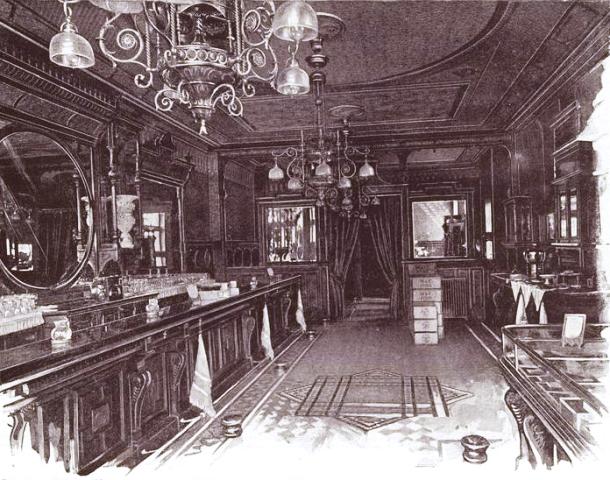
The Koster & Bial’s complex continued to grow to include an outdoor beer garden stretching along Sixth Avenue. With Koster in charge of the alcohol and Bial in charge of the performers, Koster & Bial’s was a popular boozy and burlesque-y venue.
In 1886, the partners built an annex called “The Corner” at the southwest corner of 24th Street. The annex had had a saloon and retail outlet for their beer bottling business on the ground floor and sitting rooms on the upper floors.
Trouble began when Koster & Bial’s started offering more than beer and vaudeville (wink wink). According to The New York Times, the concert hall had a notorious “cork room” in which the walls were covered with champagne bottle stoppers.
“The affairs that took place in the room in the late hours after show time would have astonished the churchgoers,” the Times noted.
Numerous police raids and the scandal they created forced Koster and Bial to close the music hall and annex on August 26, 1893. The Trocadero Vaudevilles were next to move into the music hall, followed by Bon Ton (burlesque) in 1920.
The building was torn down in 1924 and replaced by a six-story brick apartment building.
Josiah Belden moved into The Corner in 1894, operating a billiards parlor and grocery on the first floor and lodging rooms above. For many years during the late-20th century the building housed various entertainment venues until Billy’s Topless bar opened in 1970 (later renamed Billy’s Stopless).
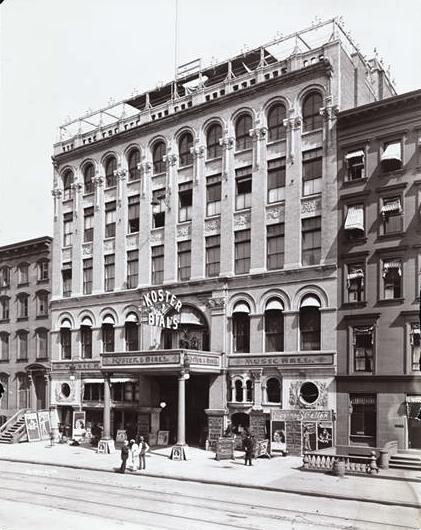
Mayor Rudolph Giuliani shut down Billy’s in 2001, and today it’s The Corner Cafe.
After getting kicked out of 23rd Street, Koster and Bial hooked up with Oscar Hammerstein. Hammerstein owned the Manhattan Opera House, a large theater built in 1892 on 34th Street at Herald Square.
Having failed to succeed with high-class opera, Hammerstein offered Koster and Bial a partnership under which he would manage the vaudeville entertainment and they would manage the food.
The new Koster and Bial’s Music Hall opened on August 28, 1893.
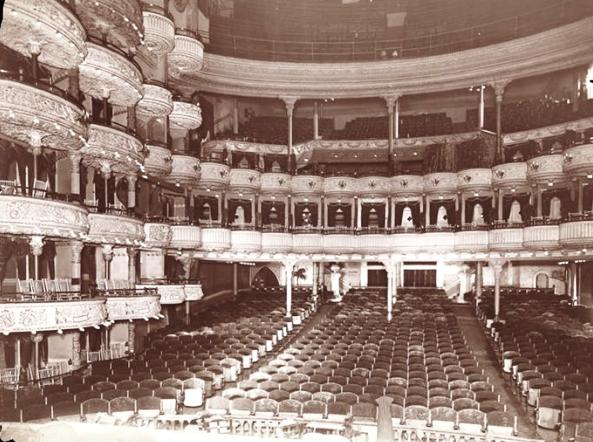
Ticket prices in the new theater ranged from 25¢ for a seat in the gallery to $1.50 for one of the 700 blue satin and silk upholstered, reserved orchestra seats. For that price, one also had a shelf on the back of his or her chair to place alcoholic beverages. The balcony level, reached by marble stairs from the foyer, had 16 exclusive boxes, and the third level refreshment promenade had tables and chairs to accommodate 800 patrons. MCNY Collections
The Kinetoscope at Koster & Bial’s
It was at Koster & Bial’s on 34th Street that inventor Thomas Armat gave the first public demonstration of the projecting kinetoscope movie projector, called the Vitascope, on April 23, 1896. The partners’ plan was to use the Vitascope to reproduce scenes from various successful plays and operas, as well as political speeches, and project them on the 12 x 20 foot screen.
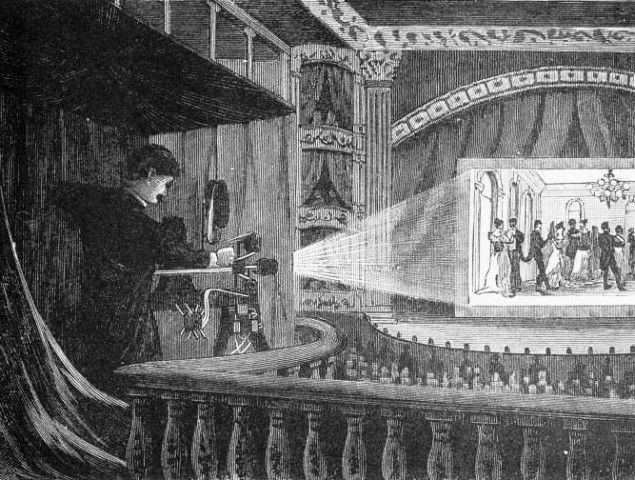
Although the music hall had some successes, it was more often plagued with financial and management issues. On July 17, 1901, Macy’s announced that it had purchased the property and would be demolishing the theater and other buildings to make way for its flagship store at 34th Street and Broadway.
Three days later, Koster and Bial’s last performance took place on the roof garden. The show ended with a chorus of performers and customers singing “Auld Lang Syne.”

The Kangaroos Keep Kicking
In the spring of 1894, Frank Bostock brought his animal show to Balmer’s Bathing Pavilion near the New Iron Pier at Coney Island. Ten years later, he opened the Bostock Arena at the brand-new Dreamland amusement park at Coney Island. Throughout these years, he continued to feature a boxing kangaroo.
Bostock died of the flu in England in 1912, about a year after the Dreamland fire (May 27, 1911), in which 60 of his 150 animals died. I don’t know if a boxing kangaroo was among those that perished in the flames.
